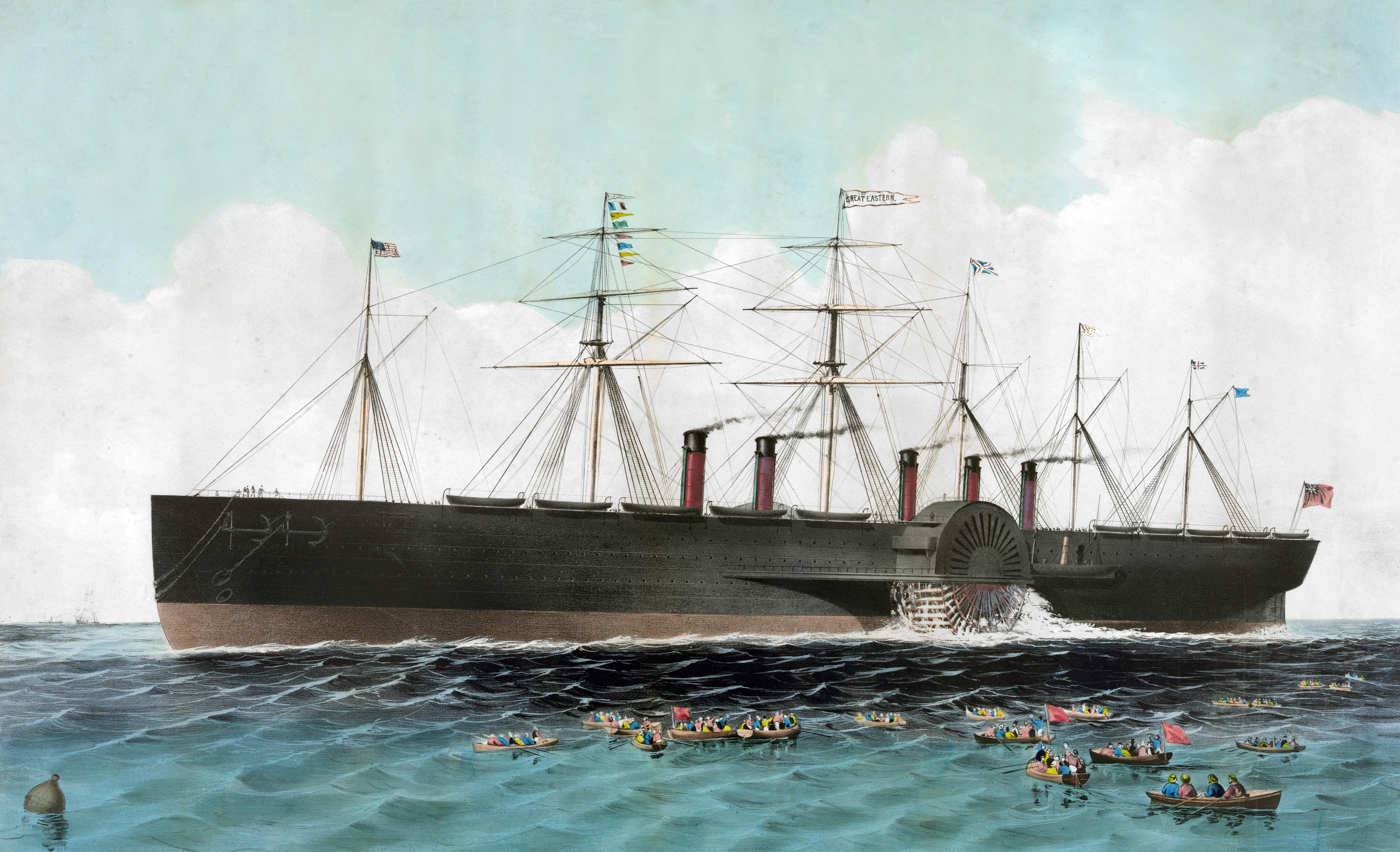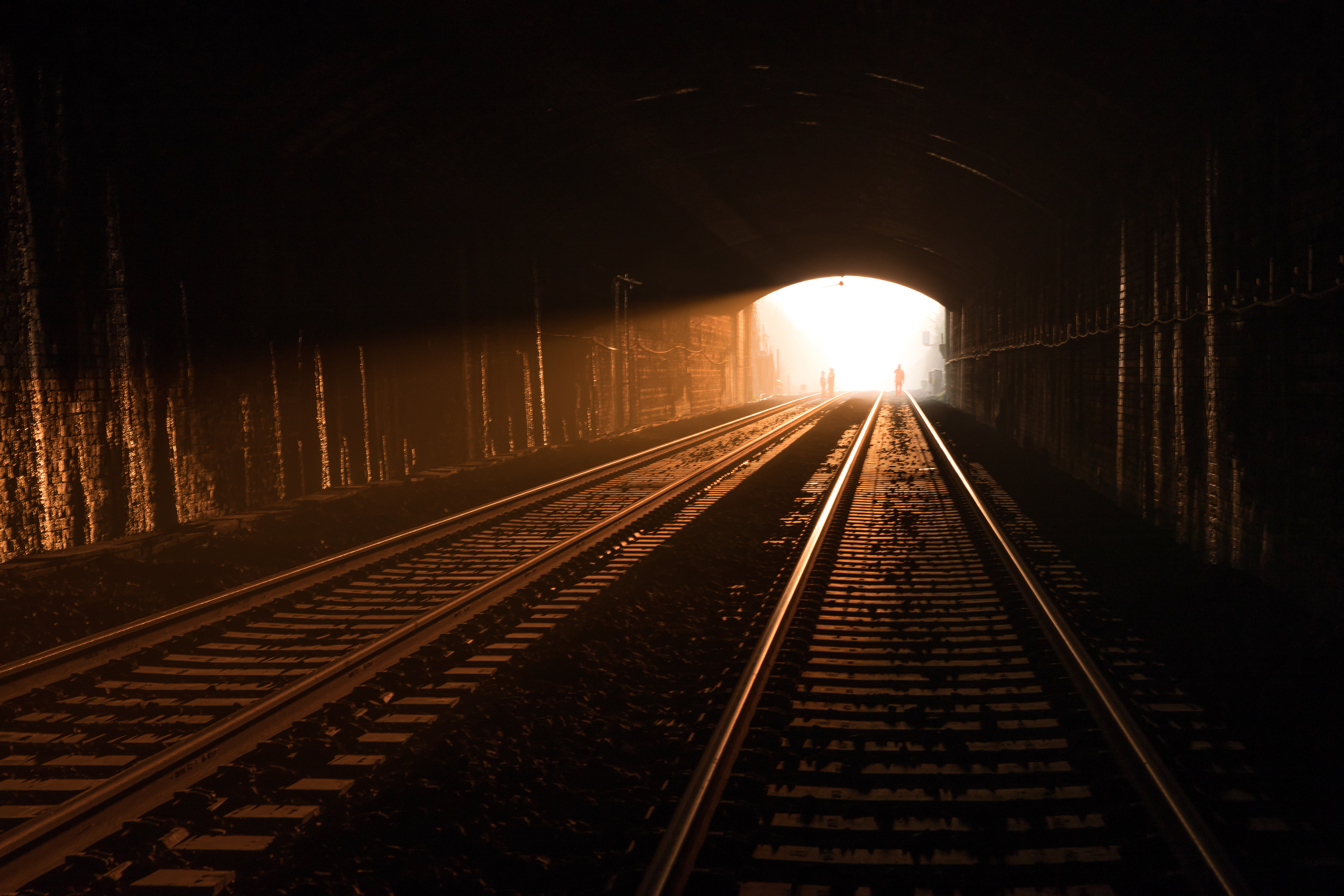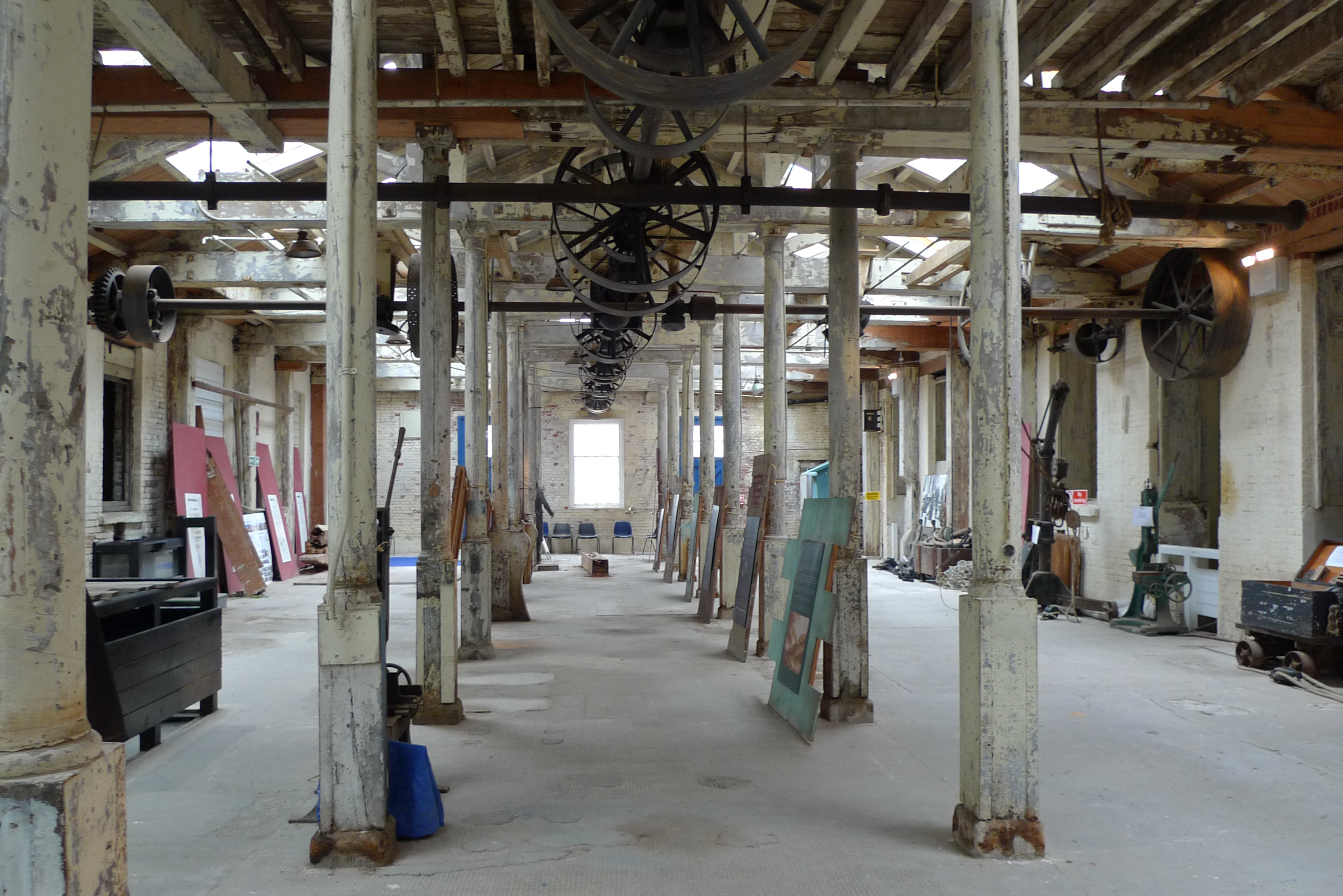|
Brunel
Isambard Kingdom Brunel (; 9 April 1806 – 15 September 1859) was a British civil engineer who is considered "one of the most ingenious and prolific figures in engineering history," "one of the 19th-century engineering giants," and "one of the greatest figures of the Industrial Revolution, hochanged the face of the English landscape with his groundbreaking designs and ingenious constructions." Brunel built dockyards, the Great Western Railway (GWR), a series of steamships including the first propeller-driven transatlantic steamship, and numerous important bridges and tunnels. His designs revolutionised public transport and modern engineering. Though Brunel's projects were not always successful, they often contained innovative solutions to long-standing engineering problems. During his career, Brunel achieved many engineering firsts, including assisting in the building of the first tunnel under a navigable river (the River Thames) and the development of the , the first ... [...More Info...] [...Related Items...] OR: [Wikipedia] [Google] [Baidu] |
Marc Isambard Brunel
Sir Marc Isambard Brunel (, ; 25 April 1769 – 12 December 1849) was a French-British engineer who is most famous for the work he did in Britain. He constructed the Thames Tunnel and was the father of Isambard Kingdom Brunel. Born in France, Brunel fled to the United States during the French Revolution. In 1796, he was appointed Chief Engineer of New York City. He moved to London in 1799, where he married Sophia Kingdom. In addition to the construction of the Thames Tunnel, his work as a mechanical engineer included the design of machinery to automate the production of pulley blocks for the Royal Navy. Brunel preferred the given name Isambard, but is generally known to history as Marc to avoid confusion with his more famous son. Early life in France Brunel was the second son of Jean Charles Brunel and Marie-Victoire Lefebvre. Jean Charles was a prosperous farmer in Hacqueville, Normandy, and Marc was born on the family farm. It was customary for the first son to inhe ... [...More Info...] [...Related Items...] OR: [Wikipedia] [Google] [Baidu] |
Isambard Kingdom Brunel Standing Before The Launching Chains Of The Great Eastern
''Isambard Kingdom Brunel Standing Before the Launching Chains of the Great Eastern'' is a photograph taken by Robert Howlett in November 1857. It shows Brunel, the British engineer, during the troubled first attempt to launch the SS ''Great Eastern'', by far the largest ship constructed to that date. Brunel stands before a drum of chain used during the launching of the vessel; he carries his customary cigar case and his boots and trousers are muddy. Brunel is smoking a cigar and his waistcoat is askew. His pose has been described as casual and self-assured. The image has become iconic of the industrial era and the 19th century and has been included in many published collections of photographs. It was widely reproduced at the time of the ship's eventual launch in January 1858 and again after Brunel's death in 1859. Background Isambard Kingdom Brunel was a British engineer who constructed a number of innovative civil and railway engineering projects and, in 1845, the SS ... [...More Info...] [...Related Items...] OR: [Wikipedia] [Google] [Baidu] |
Royal Albert Bridge
The Royal Albert Bridge is a railway bridge which spans the River Tamar in England between Plymouth, Devon and Saltash, Cornwall. Its unique design consists of two lenticular iron trusses above the water, with conventional plate-girder approach spans. This gives it a total length of . It carries the Cornish Main Line railway in and out of Cornwall. It is adjacent to the Tamar Bridge which opened in 1962 to carry the A38 road. The Royal Albert Bridge was designed by Isambard Kingdom Brunel. Surveying started in 1848 and construction commenced in 1854. The first main span was positioned in 1857 and the completed bridge was opened by Prince Albert on 2 May 1859. Brunel died later that year and his name was then placed above the portals at either end of the bridge as a memorial. During the 20th century the approach spans were replaced, and the main spans strengthened. It has attracted sightseers since its construction and has appeared in many paintings, photographs, guidebook ... [...More Info...] [...Related Items...] OR: [Wikipedia] [Google] [Baidu] |
Great Western Railway
The Great Western Railway (GWR) was a British railway company that linked London with the southwest, west and West Midlands of England and most of Wales. It was founded in 1833, received its enabling Act of Parliament on 31 August 1835 and ran its first trains in 1838 with the initial route completed between London and Bristol in 1841. It was engineered by Isambard Kingdom Brunel, who chose a broad gauge of —later slightly widened to —but, from 1854, a series of amalgamations saw it also operate standard-gauge trains; the last broad-gauge services were operated in 1892. The GWR was the only company to keep its identity through the Railways Act 1921, which amalgamated it with the remaining independent railways within its territory, and it was finally merged at the end of 1947 when it was nationalised and became the Western Region of British Railways. The GWR was called by some "God's Wonderful Railway" and by others the "Great Way Round" but it was famed as the "Holi ... [...More Info...] [...Related Items...] OR: [Wikipedia] [Google] [Baidu] |
Thames Tunnel
The Thames Tunnel is a tunnel beneath the River Thames in London, connecting Rotherhithe and Wapping. It measures 35 feet (11 m) wide by 20 feet (6 m) high and is 1,300 feet (396 m) long, running at a depth of 75 feet (23 m) below the river surface measured at high tide. It is the first tunnel known to have been constructed successfully underneath a navigable river and was built between 1825 and 1843 by Marc Brunel and his son Isambard using the tunnelling shield newly invented by the elder Brunel and Thomas Cochrane. The tunnel was originally designed for horse-drawn carriages, but was mainly used by pedestrians and became a tourist attraction. In 1869 it was converted into a railway tunnel for use by the East London line which, since 2010, is part of the London Overground railway network under the ownership of Transport for London. History and development Construction At the start of the 19th century, there was a pressing need ... [...More Info...] [...Related Items...] OR: [Wikipedia] [Google] [Baidu] |
Clifton Suspension Bridge
The Clifton Suspension Bridge is a suspension bridge spanning the Avon Gorge and the River Avon, linking Clifton in Bristol to Leigh Woods in North Somerset. Since opening in 1864, it has been a toll bridge, the income from which provides funds for its maintenance. The bridge is built to a design by William Henry Barlow and John Hawkshaw, based on an earlier design by Isambard Kingdom Brunel. It is a Grade I listed building and forms part of the B3129 road. The idea of building a bridge across the Avon Gorge originated in 1753. Original plans were for a stone bridge and later iterations were for a wrought iron structure. In 1831, an attempt to build Brunel's design was halted by the Bristol riots, and the revised version of his designs was built after his death and completed in 1864. Although similar in size, the bridge towers are not identical in design, the Clifton tower having side cut-outs, the Leigh tower more pointed arches atop a red sandstone-clad abutment. ... [...More Info...] [...Related Items...] OR: [Wikipedia] [Google] [Baidu] |
Henry Marc Brunel
Henry Marc Brunel (27 June 1842 – 7 October 1903) was an English civil engineer and the son of the celebrated engineer Isambard Kingdom Brunel and grandson of civil engineer Marc Isambard Brunel. Henry Marc Brunel was born in Westminster, London on 27 June 1842, the second son of the celebrated engineer Isambard Kingdom Brunel and Elizabeth Mary Horsley. He decided to follow his father and grandfather's footsteps by becoming a civil engineer. Brunel attended King's College London from 1859–1861, and then gained experience in civil engineering through serving out various apprenticeships. He helped take down his father's Hungerford Bridge with Sir John Hawkshaw so the chains are now at Clifton Suspension Bridge. He conducted initial surveys for a Channel Tunnel. He developed an interest in acting as a hobby, becoming a member of the Scientific and Amateur Dramatic Societies, and also contributed to his brother's biography of their father. Henry is noted for a partnership fr ... [...More Info...] [...Related Items...] OR: [Wikipedia] [Google] [Baidu] |
Box Tunnel
Box Tunnel passes through Box Hill on the Great Western Main Line (GWML) between Bath and Chippenham. The tunnel was the world's longest railway tunnel when it was completed in 1841. Built between December 1838 and June 1841 for the Great Western Railway (GWR) under the direction of Isambard Kingdom Brunel, the straight tunnel descends on a 1 in 100 gradient from its eastern end. At the time the tunnel's construction was considered dangerous due to its length and the composition of the underlying strata. The west portal is Grade II* listed and the east portal is Grade II listed. Ammunition was stored near the tunnel during World War II, reusing mine workings. During the 2010s, the tunnel was modified and the track lowered to prepare it for electrification. History Background During the 1830s, Isambard Kingdom Brunel developed a plan for a railway running east–west between London and Bristol. The Great Western Main Line, would maintain either level ground or gentle gradien ... [...More Info...] [...Related Items...] OR: [Wikipedia] [Google] [Baidu] |
Steamship
A steamship, often referred to as a steamer, is a type of steam-powered vessel, typically ocean-faring and seaworthy, that is propelled by one or more steam engines that typically move (turn) propellers or paddlewheels. The first steamships came into practical usage during the early 1800s; however, there were exceptions that came before. Steamships usually use the prefix designations of "PS" for ''paddle steamer'' or "SS" for ''screw steamer'' (using a propeller or screw). As paddle steamers became less common, "SS" is assumed by many to stand for "steamship". Ships powered by internal combustion engines use a prefix such as "MV" for ''motor vessel'', so it is not correct to use "SS" for most modern vessels. As steamships were less dependent on wind patterns, new trade routes opened up. The steamship has been described as a "major driver of the first wave of trade globalization (1870–1913)" and contributor to "an increase in international trade that was unprecedented in ... [...More Info...] [...Related Items...] OR: [Wikipedia] [Google] [Baidu] |
Sophia Kingdom
Sophia Kingdom (15 February 1775 – 5 January 1855), later known as Lady Brunel, was the mother of Isambard Kingdom Brunel. Her father was William Kingdom, a contracting agent for the Royal Navy and the army, and her mother was Joan Spry. She was born in Plymouth, England. She was the youngest of sixteen children. When she was eight years old, her father William died (1783). Sophia Kingdom was sent to France to improve her knowledge of the French language. She became ill on the journey over, and whilst her travelling companions decided to return to England to avoid the escalating unrest in France, she was unable to accompany them and instead remained in France. While working there as a governess she met Marc Isambard Brunel (1769–1849) at Rouen in the early 1790s. In 1793, Marc Brunel had to flee the French Revolution, going to the United States, but Sophia remained in Rouen. During the Reign of Terror, she was arrested as an English spy, and daily expected to be executed. She ... [...More Info...] [...Related Items...] OR: [Wikipedia] [Google] [Baidu] |
Portsmouth Block Mills
The Portsmouth Block Mills form part of the Portsmouth Dockyard at Portsmouth, Hampshire, England, and were built during the Napoleonic Wars to supply the British Royal Navy with pulley blocks. They started the age of mass-production using all-metal machine tools and are regarded as one of the seminal buildings of the British Industrial Revolution. They are also the site of the first stationary steam engines used by the Admiralty. Since 2003 English Heritage has been undertaking a detailed survey of the buildings and the records relating to the machines. Development of Portsmouth Dockyard The Royal Navy had evolved with Britain's development by the middle of the eighteenth century into what has been described as the greatest industrial power in the western world. The Admiralty and Navy Board began a programme of modernisation of dockyards at Portsmouth and Plymouth such that by the start of the war with Revolutionary France they possessed the most up-to-date fleet fa ... [...More Info...] [...Related Items...] OR: [Wikipedia] [Google] [Baidu] |
Robert Howlett
Robert Howlett (3 July 1831 – 2 December 1858) was a pioneering British photographer whose pictures are widely exhibited in major galleries. Howlett produced portraits of Crimean War heroes, genre scenes and landscapes. His photographs include the iconic picture of Isambard Kingdom Brunel which was part of a commission by the London-based weekly newspaper ''Illustrated Times'' to document the construction of the world's largest steamship, the SS ''Great Eastern''. He exhibited at the London Photographic Society and published ''On the Various Methods of Printing Photographic Pictures upon Paper, with Suggestions for Their Preservation.'' He worked in partnership with Joseph Cundall at "The Photographic Institution" at New Bond Street, London. Howlett made photographic studies for the artist William Powell Frith to assist him on his vast modern panorama painting '' The Derby Day'' (1856–58; Tate, London) which was exhibited at the Royal Academy of Arts in 1858. Howlett ... [...More Info...] [...Related Items...] OR: [Wikipedia] [Google] [Baidu] |










